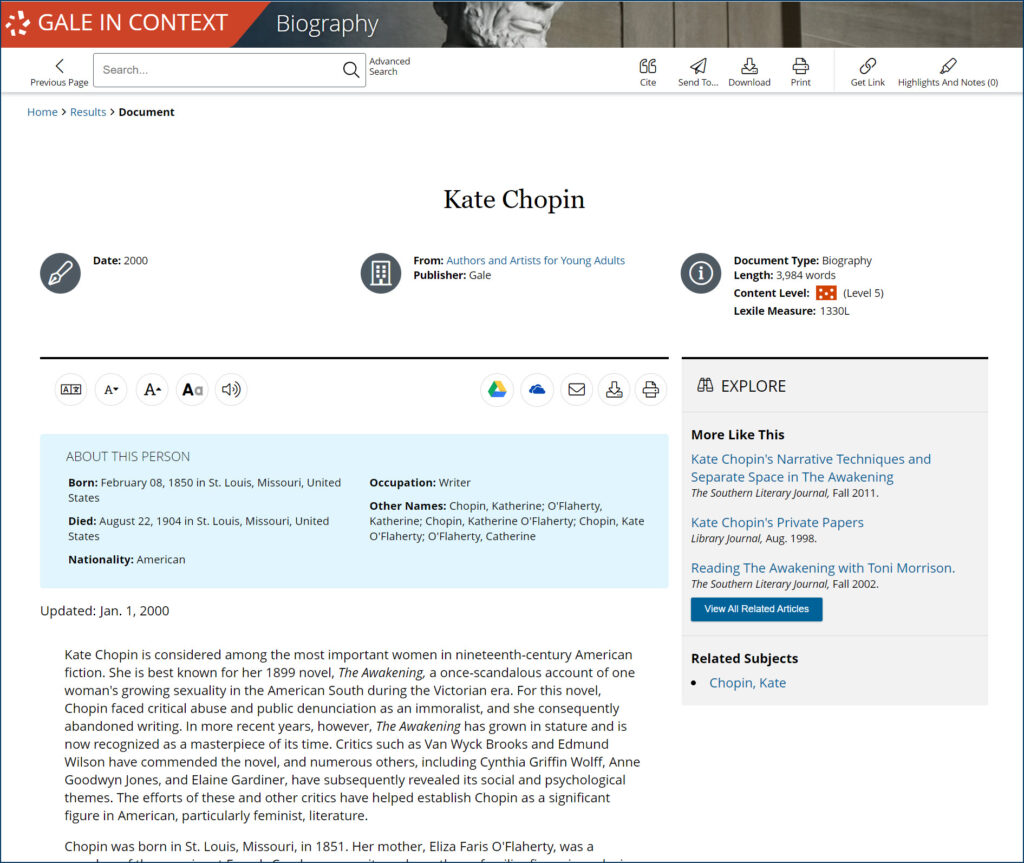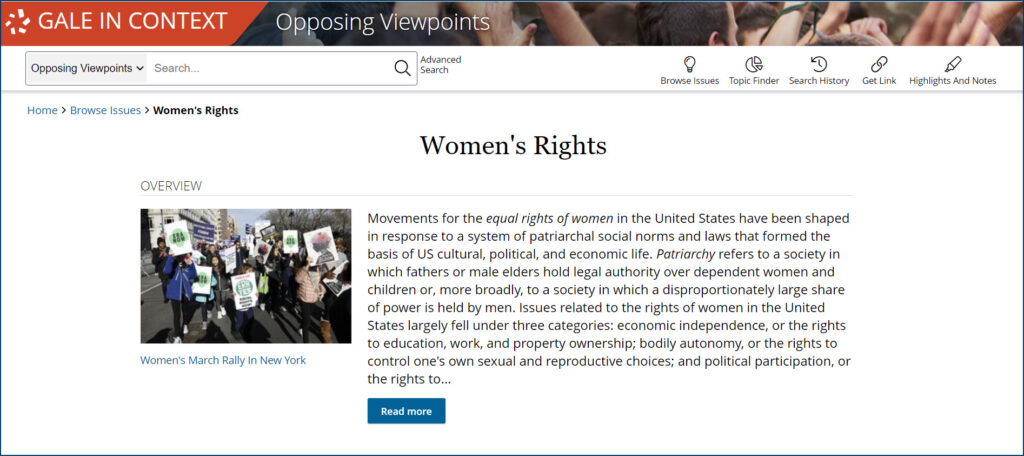| By Gale Staff |
You have to have a particular kind of passion to be an ELA teacher. One that compels you to dig deep past the words on the page to find the soul of the story—the era in which it was penned, the societal norms that the author faced, and the personal trials and triumphs of its creator. Helping our students appreciate literature as a tool to understand history through the eyes of the people who lived it is one of the greatest gifts we can give them.
Take, for example, a story like Kate Chopin’s “The Story of an Hour.” After one read, it seems to be just a narrative about the final hour of a woman’s life: Her husband dies, she locks herself away to ponder her new circumstances—and then, surprise! Her husband reappears, and she, quite literally, dies of shock. With even a modicum of context, though, it’s hard not to be impressed by Chopin’s ability to perfectly depict the secret lives and thoughts of late 19th-century women in 1,013 words.
Today, we’ll work with Kate Chopin’s 1894 short story, Charlotte Perkin Gilman’s The Yellow Wallpaper, and Jamaica Kincaid’s Girl to exemplify how Gale In Context’s English Language Arts resources breathe life into the literature, pushing learners to look past the superficial and think critically about what makes a piece enduring and relevant more than a century later.
Contextualize an Author’s Life and Times
The first step that students should take before digging into a text is spending time getting to know the author. Not only does it help us understand the when but also the why behind an author’s choice of topics, writing style, vocabulary, and perspectives.
Gale In Context: Biography is the tool for the task, featuring biographical entries covering hundreds of thousands of the world’s most influential people, including the authors your students will study.
Born in 1850 in St. Louis, Missouri, as Katherine O’Flaherty, Kate Chopin grew up in the Catholic Church as the daughter of a French-Creole socialite mother and an Irish father. After traveling to New Orleans to expand her horizons at 19 years old, she raised a few eyebrows by engaging in such scandalous behaviors as smoking cigarettes and walking through the city unaccompanied by a man.
Eventually, she met and married native Louisianan Oscar Chopin. Unfortunately, she became a widow at 32 when Oscar died of swamp fever, leaving her to raise six children on her own. She moved back to St. Louis at her mother’s behest, but Chopin lost even this source of support when Mrs. O’Flaherty died less than a year later.
At this point, Chopin began writing at the encouragement of a family friend as a means of coping with her grief. In her works, she focuses on the themes of social norms, marital relationships, female autonomy, and the responsibilities of motherhood against the backdrop of postbellum Louisiana.
Chopin was also influenced by the broader literary movement of Realism. This era directly opposed American Romanticism, which lasted from approximately 1820 to 1865, when the Civil War ended. After four years of bloodshed, the aspirational, transcendental ideas of American Romantic writers were rejected in favor of postbellum works that “strove to portray the everyday experiences of everyday people in real life.”
With that in mind, “The Story of an Hour” is a quintessential example of the Realism era, with a linear narrative and focus on the internal psychological state of the protagonist, Mrs. Louise Mallard, as she comes to realize the newfound freedoms that the death of her husband allows.
Compare Works Across Genres, Themes, and Eras
Gale In Context: Literature is one of the most in-depth and interactive educational platforms available. This teaching and learning tool compiles more than 300 topic overviews for a diverse range of poetry, prose, speeches, short stories, and more.
With Literature, students can easily access other works within a particular theme, era, and genre so they can continue their exploration of new authors and texts, including Chopin’s contemporaries.
In the late 19th and early 20th centuries, one of the only ways that many women could explore a life outside of the domestic sphere was through writing, leading to the rise of the feminist literary genre. With Gale In Context: Literature’s bookshelf-style organization system, students only need one click to access other feminist texts and compare different narrative strategies to those used in “The Story of an Hour.”
A great starting point is Charlotte Perkins Gilman’s “The Yellow Wallpaper” (1892).
The short story gives us an eerie peek into the life of an unnamed woman’s mental deterioration after she’s confined for “nervous depression”—which we now know is most likely postpartum depression—to a bed in a nursery room. She’s forbidden from seeing her baby, socializing, writing, and just about anything else that’s not staring out of a window. Her husband, also her doctor, is patronizing, referring to her as a “little girl” and constantly invalidating her insights into what would make her feel better— “congenial work, with excitement and change.”
Gilman is still toying with the tenets of Romanticism with her descriptions of the seemingly supernatural nature of the women in the wallpaper, while Chopin’s work is more firmly rooted in Realism. That said, they communicate the same message: Men have dominance over women and use their position in society to trap women—literally and figuratively—within the confines of domesticity and motherhood.
Explore Global Perspectives
Societal norms and expectations don’t look the same the world over, and students can tap into these diverse perspectives on the topics and themes they’re reading about in class with Gale In Context: Global Issues.
In Jamaica Kincaid’s prose poem “Girl,” published in 1978, the Caribbean-American author writes a list of “life tips” from a mother to a daughter, interlacing the practical advice with instructions on how to act like a lady and “not like the slut [the daughter is] so bent on becoming.”
Consider this line:
“. . . this is how you grow okra—far from the house because okra tree harbors red ants; when you are growing dasheen, make sure it gets plenty of water or else it makes your throat itch when you are eating it . . .”
Then, consider this statistic from an article titled “Our culture promotes bias and inequality” from The Independent: “In sub-Saharan Africa and the Caribbean, women produce some 80 percent of basic foodstuffs, but many go unpaid.”
Kincaid lived the reality described in the article, learning from her mother how to grow food with the expectation that she would be responsible for cultivating her family’s food by hand, just as her mother did and her mother’s mother before.
Another example of how Gail In Context can give students more insights into their text is the line, “. . . this is how to bully a man; this is how a man bullies you; this is how to love a man, and if this doesn’t work there are other ways, and if they don’t work don’t feel too bad about giving up . . .”
Compare that to an entry from the Worldmark Encyclopedia of Cultures and Daily Life on Antigua and Barbuda, the former of which is Kincaid’s birthplace: “Violence against women, including spousal abuse, is a problem in both Antigua and Barbuda. The Domestic Violence Act prohibits and provides penalties for domestic violence, rape, and other sexual offenses, with maximum sentences (rarely imposed) ranging from 10 years to life imprisonment.”
Perhaps the mother was sharing her own experiences with spousal violence and how her daughter can defend herself when it inevitably happens while recognizing that there is no shame in walking away from an unhealthy relationship.
Nearly a century removed from Chopin’s work, Kincaid brings a more modern, diverse voice to the conversation about women’s fates and the expectations passed on through the generations. Chopin’s works were informed by a life of privilege—one in which women were coddled, infantilized, and forcefully separated from any sense of agency they may feel entitled to.
Half a world away, Kincaid spoke of a similar lack of control that women have, but from a very different perspective.
Even 140 years after slavery ended in Antigua, Kincaid was still experiencing the consequences of colonialism and the effects of the “European disease” in which the Commonwealth attempted to “turn Antigua into England and the natives into English.” When Girl was written, the nation had only been self-governing for 11 years and wouldn’t be granted status as an independent nation until 1981.
Kincaid draws a parallel between the way that women and colonial nations are treated. Both are forced to bear the burden that others put upon them to be deemed “acceptable” and “proper,” but it’s a one-sided conversation. You either do what you’re told, or you’ll be ostracized and punished.
Like Chopin, Kincaid lived under the thumb of sociocultural expectations about gender–one in which women are stripped of their prerogative and power– demonstrating that even in very contrasting cultural contexts, the oppression of women is a nearly universal theme in literature.
Master Argumentative Writing
One of the most challenging essential ELA skills is logical, evidence-supported argumentative writing, especially when your learners are tasked with exploring both sides of the argument.
Using Gale In Context: Opposing Viewpoint’s content on Women’s Rights, your students can explore how opinions and legislation around gender equality have changed (or not) since 1894, when Chopin published her short story, to answer one of the essential questions included in the portal: “In the 21st century, are women any more likely than men to feel constrained by a relationship?”
Opposing Viewpoints is unbiased and comprehensive, so your students can find evidence supporting both sides of the argument, from pieces opposing ratification of the Equal Rights Amendment and gender equality as an assault on the marriage dynamic to calls for further protections for women’s reproductive rights.
Students also have access to a collection of visual resources, including statistical graphics, videos, audio recordings, and more, to keep learners engaged with multimedia content tailored to their interests and learning styles.
Gale In Context Offers a Full Suite of Tools for Deeper Connections to Literature
The Gale In Context English language arts platforms are extensive repositories of curriculum supports, from videos that help visual learners engage with the text to contemporaneous reviews that explore the many perspectives behind a piece.
All these resources work in tandem to integrate seamlessly with your learning management system (LMS), making it easier and more efficient to put literature in context with in-depth literary analysis.
Are you interested in bringing Gale In Context to your classroom? Fill out our form to request a virtual tour of these engaging ELA resources.




